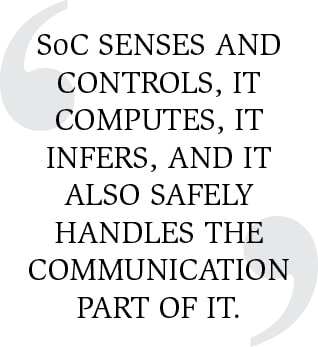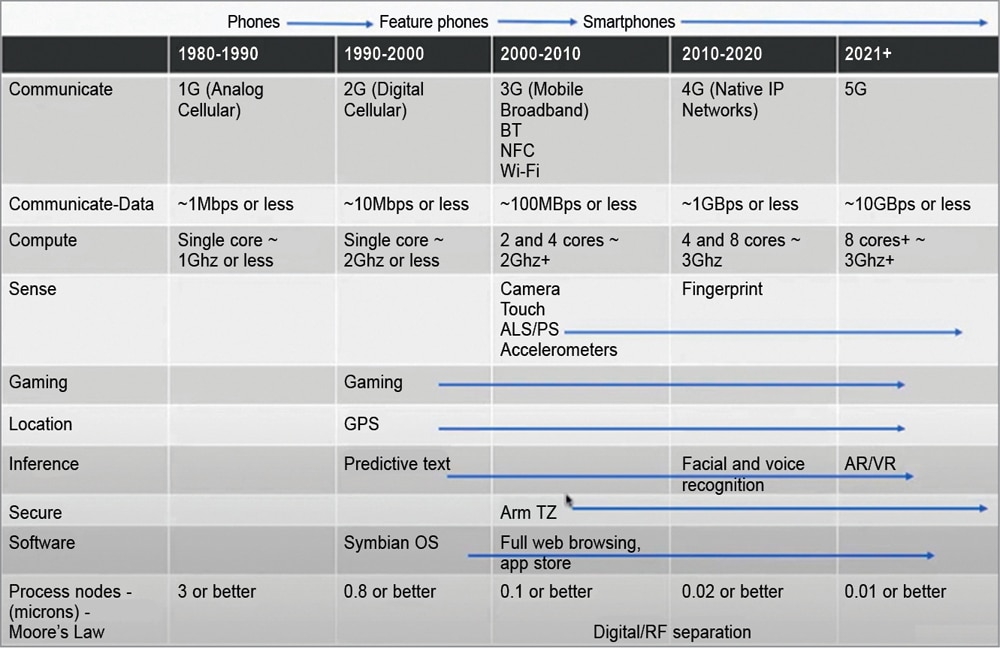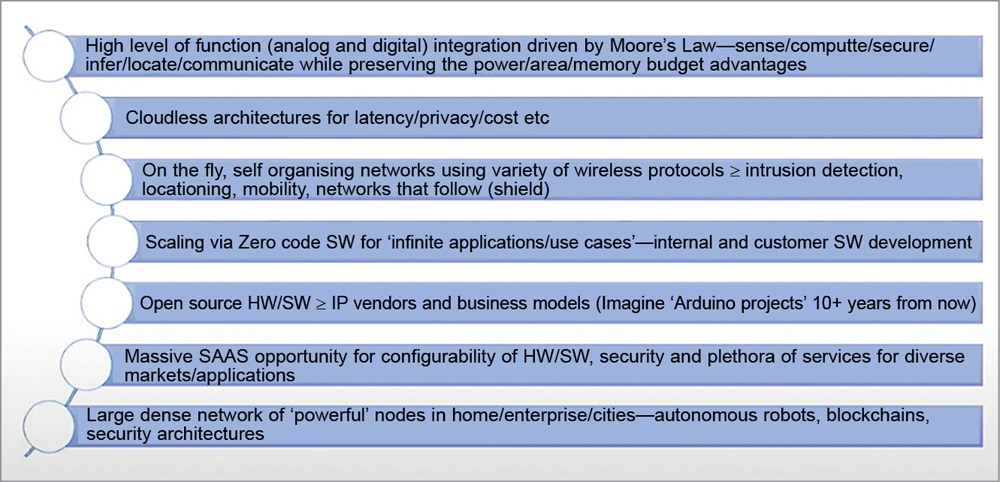“I believe IoT will disrupt multiple industries in the coming decade and beyond,” says Manish Kothari, Senior Vice President of Software Development at Silicon Labs. In his keynote address at the VLSI Design Conference 2022, Manish talked about the challenges and future of IoT and its potential to be one of the most disruptive technologies of this century.
In today’s time, safety and comfort are paramount, and automation is playing an active role in enhancing lifestyle, safety, and comfort along with improved efficiency. And to realise automation, gathering and processing data is the most crucial part, which is taken care of by the Internet of Things (IoT).
In a layman’s terms, IoT is basically connecting different applications and sensors to the cloud or connecting them to the internet using a variety of different wireless protocols. The inclusion of IoT on a large scale has not just improved the quality of life but has also increased the complexity manifold.
IoT is simple yet complex
IoT solutions seem straightforward but are not as simple as they sound. For example, an embedded system, which is the backbone of an IoT system, is often a low-powered device performing a simple task, which can easily be performed by even a low-cost smartphone, or a decade-old microcontroller (MCU) combined with a simple sensor that is easily available in the market.
The real challenge here is not to complete the task or gather data but to do all of it in a space-constrained, budget-constrained, power-constrained system that can work for years without any human intervention. And not to forget about the security, which in an IoT system is paramount. Furthermore, there is a time-relevance aspect to the IoT solution, that is, the product and its components should remain relevant for at least 5 to 10 years.
“The IoT solution has at least a 5-to-10-year life,” says Manish. “So, there is a time relevance aspect of the hardware and software, both of which cannot go obsolete. You must be able to upgrade the capability of your devices, capabilities of your hardware and software, till the time an end customer has the product.”
Selecting the right SoC
An IoT system needs to sense, communicate, perform inference and computation, while taking the security of the system and data into consideration. These things require tight integration of hardware-software architecture. Designers need to design compact products, running on minimum power, and utilising really low bandwidth while costing extremely low.
To achieve all of this the selection of an optimum system-on-chip (SoC) is very critical. SoC is one of the main components that play a crucial role in integrating all the components in an embedded system.
In addition to the discussed problems, the SoCs must last for years and, in many cases, last over a decade on a single coin-cell battery. So, very tight integration of all the aspects is necessary for a good IoT solution. To overcome the problem, engineers are trying to simplify inferencing, and to achieve that we can observe the development of Micro Edge.
Inference at Micro Edge
The inference is turning raw data from the sensors and other IoT devices into a piece of actionable information. In the inference we have seen a development of Micro Edge. Although sounding too fancy, Micro Edge is nothing but where your sensors and devices are residing.
According to Manish, “When you do inferencing right at the sensor or near the device, you are taking care of security, you are sending that inferred solution or the inference across as opposed to the live data. So, it gives you lower latency. It gives you a more secure solution, and obviously, it is cost-effective.” He adds, “This is a growing use-case where inferencing is occurring right at what we call Micro Edge by the sensors and devices out there in the field.”
Need for configurable system
The IoT applications are very diverse. From a light bulb to a health monitor, to machinery in a factory to an asset tracker, we have diverse applications and various micro verticals, with very different requirements for each one of them in every vector.
Therefore, designing a one-fit solution for all situations is not possible. But being a low-cost solution, it is also not feasible for a company to do R&D from ground zero for every single product. You must do quick turn derivatives in order to stay relevant.
Furthermore, there are industrial and commercial customers with massive quantity requirements who want to have their own ecosystems and not of Google, Amazon, etc for privacy, security, and confidentiality. So, new players in the IoT segment have a wide variety of opportunities to tap in.
“We have diverse applications and various micro verticals, with different requirements for each one of them in every vector, whether it is sense requirements, compute requirements, etc. Your hardware-software needs to be configurable,” adds Manish.
Finding the right opportunity
IoT has the potential to change how we do a lot of things. We are not just connecting things, or inferring things because it’s cool, but because it has the potential to change the world. Apart from enhancing convenience and improving the lifestyle, Manish also feels that it will transform a variety of industries; it will transform even those industries that are considered low-tech, such as the construction industry.
Manish gives an example of how IoT can become beneficial for the construction industry, which does not usually require automation. He claims that the maximum amount of time and resources are not efficiently managed in the construction industry, and deadlines often get extended due to multiple reasons, such as improper management of inventory, work getting delayed, or resources being wasted due to bad weather or improper working conditions.
These are the areas where IoT can streamline things. IoT can help get live data of these tools, machines, and equipment, the utilisation of the equipment and tools, and their efficiencies. All these parameters are very critical for delivering projects on time.
Manish also believes that there are other parameters, such as how and when you service and maintain your equipment, or the status of the secure access for some of these construction sites where there is a danger of operation, like in mining operations, where you have to take personal safety into account. So, how do you ensure secure access?
There are clear problems right in front of us that we need to identify and solve to improve lives, improve businesses, their efficiencies, and the money that they make. This is just one industry. Nobody’s going to give us a lot of money to just look cool. And unless we start solving real problems using IoT, the technology will not take off.
What the future holds
“IoT will disrupt multiple industries in the coming decade and beyond.”
Disruption occurs due to technologies that are generally cheaper and simpler to use. Initially, in terms of performance, these disruptive technologies are only suitable for a small number of users. Over time, these technologies improve and become a necessity for most people.
This phenomenon has occurred over time and again. One such example is of the smartphone, which is making cameras, audio players, PCs, handheld GPS, and many other things obsolete.
According to many industry stalwarts, IoT will disrupt multiple industries in the coming decades.
To predict the growth of IoT we may look at the evolution of smartphones. The timeline of phones is shown in Fig. 1.

As can be seen, there was massive advancement with each successive decade. Alongside the features in the phone’s hardware, the networking technology kept improving. From 1G in the 80s, which could transfer less than 10kbps, the growth in data transfer rate kept on improving by a factor of ten.
The inception of digital cellular technology in 1990s changed the scope of mobile phones. From just a device to make calls the mobile device had added functionalities, such as gaming and GPS, and in terms of inference we got a new feature of predictive text.
Then the next big development happened in the 2000s, when the data transfer rate jumped from 64kbps to over 1Mbps. The phones now had cameras, touchscreens, accelerometers, etc. This is when mobile phone technology really disrupted the market. The processor in smartphones began catching up with the basic PCs, the phone cameras affected the sale of low-level point-and-shoot cameras, and many different gadgets were affected due to these powerful smartphones.
Smartphones were no longer merely a tool for communication but became much more than that. We saw a very high level of integration of the various functions, including computing prowess, sense, and gaming—all of these started to disrupt several industries.
The advancement made in the first decade caused major adoption of smartphones, thus bringing a flood of manufacturers driving the cost lower and lower with each passing year. The rate of refinement and growth continued in the 2010s. The inception of 4G improved the internet speed and the processing power of mobiles was now comparable to baseline PCs.
The phone cameras started to outperform the basic cameras. And similar was the fate of music players, such as MP3 players and iPods. Smartphones were no more a novelty but a necessity.
We have just set foot in the 2020s, but by now smartphones pack enough power to compete with decent PCs, cameras, etc. Some of the latest models have higher RAM and processing power than most entry-level laptops. They offer much higher resolution than most cameras, and the 5G internet is capable of matching or even exceeding the data transfer rate of cabled internet available in many areas.
Smartphones are now secure enough to do banking transactions and, in many countries, are being used as the primary mode for everyday transactions. However, it is too early to discuss the advancements that are likely to be made by smartphones in this decade!
The future of IoT
IoT technology is in its second generation in terms of development. Compared to mobile phones, IoT is where the phones were in 1990s as feature phones. The IoT technology is being adopted by a few, but it is yet to become a necessity for most.
From a process node standpoint, in terms of our inferencing capability, in terms of our compute capability, we are nowhere close to gigahertz, right? We have the sub-gigahertz capability today. So, these are very early days for IoT. Very likely, as the Moore’s Law progresses, the sense of integration will also progress, and there will be dislocations that vendors and players will benefit from.

We normally think of Moore’s Law as digital integration, and we can say that the IoT is at a beginning of Moore’s Law journey. It could possibly have a high level of function integration driven by Moore’s Law. When we talk about sensors, there is a variety of analogue front-ends on the sensors that can get integrated. So, there’s going to be a high degree of integration.
It is again similar to the case of smartphones, with a lot of constraints. Compared to the technologies smartphones were battling – which included PCs, servers, camera, etc – the smartphone had constraints of power, space, memory, and budget. So, it is safe to say that the constraints of the IoT are similar.
We can expect a high level of integration that will come in next few decades. Some other expectations are:
Cloudless architecture to overcome design constraints
Cloudless technology will enhance various domains of the IoT. It will provide greater choice and agility while reducing cost for applications that incorporate state-of-the-art hardware, software, and data access. You can think of a variety of cloudless architectures, like mesh networks that offer better latency and privacy. In fact, there are some companies already thinking about piloting peer-to-peer cloudless architectures. Therefore, privacy and reduced latency will be the biggest reason for the adoption of cloudless technology.
Self-organising network
A self-organising network (SON) uses artificial intelligence (AI), predictive analytics, and pre-optimised software algorithms to offer automated functions, such as self-configuration, self-optimisation, self-healing, and self-protection. SONs simplify network administration by enabling the creation of a plug-and-play environment for a network task. There are over fifty different wireless protocols that serve a variety of different needs. Bluetooth has a different role than Wi-Fi and so does the sub-gigahertz protocol that gives you a range of a few kilometres.
The benefit of implementing SON is that it will allow us to change the protocols on the fly. For example, the transmitter radios can automatically adjust parameters such as transmission power to avoid interference and maximise both coverage and capacity. It also provides better security as the self-organising network automatically defends itself from penetration by unauthorised users.
Open source software
The other very interesting thing that is bound to happen in software is scaling. In a world with infinite applications and use-cases, it is not possible to serve each individual customer’s requirements. This is where a zero-code solution holds the potential to change the world. The zero-code solution will allow the customers to take the code, drag and drop connectors in a visual platform—and the code is outputted and the product is ready to go.
Growth with open source hardware
Open source hardware (OSH) is free-to-use physical artefacts of technology that can be made and used by anyone without any copyright infringement. There is a big open source community supported by electronics makers and DIYers all around the globe. One such example is of Arduino projects for microcontrollers and NodeMCU, which is an open source IoT platform. OSH is bound to grow and result in a variety of different business models that will disrupt the industries. Furthermore, it will empower individuals to create IoT solutions, thus democratising IoT.
Massive SAAS opportunity
The need for configurability of hardware and software creates a huge opportunity for software as a service (SAAS). Since there is a diverse market with specific requirements, IoT needs to meet a plethora of different demands, such as security and time relevance. So, there is an opportunity for a large dense network of powerful nodes. For example, every lighting pole present in the smart grid will have some sort of SoC that can self-organise and help you with location, sensing, etc. You can also think about running blockchain on it.
Although it seems far-fetched, we are talking about these in the future because we will have powerful computing power in these nodes. We are thinking about the 5G equivalent of IoT, which will have 8, 10, 12 cores offering significant compute power. Memory is only going to grow in all of these massive networks that would be available in the future.
These are all predictions, but what is certain is that the IoT holds the ability to disrupt a lot of industries and change the world for greater good.
This article is based on Manish Kothari’s keynote address at the VLSI Design Conference 2022. He is Sr VP of Software Development at Silicon Labs. The article has been transcribed and curated by Sharad Bhowmick, who works as a tech journalist at EFY.
Manish Kothari is Senior Vice President of Software Development at Silicon Labs









great